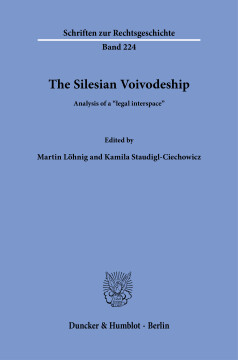(image source: Duncker & Humblot)
Abstract:
After World War I, the reorganisation of Europe created many legal interspaces. This volume is intended to be a first step towards in-depth research into Upper Silesia as a legal interspace. The focus is on Upper Silesia as an autonomous region and the jurisdiction in the Silesian Voivodeship. Seven contributions by Polish and German scholars examine the question of autonomy from an interdisciplinary perspective - historical, legal and political. The contributions compare Silesian autonomy with other Polish autonomy projects of the interwar period and situate it in contemporary legal discourse and political debate. At the same time, an arc is drawn to current attempts at autonomy in Poland. Another focus is the question of jurisdiction in Upper Silesia from a national and international perspective.
Table of contents:
Martin Löhnig: Introduction 5 Table of Contents 7 Ryszard Kaczmarek: Autonomy of the Silesian Voivodeship and Other Projects of Regional Autonomies in Poland 1918–1939 9 I. The Autonomy Traditions in Poland after the First World War 9 II. Administrative Standardization or Decentralization: the Political Dilemma of the Second Polish Republic 11 III. Autonomy Projects in Poland after World War I 13 1. Territorial Autonomies 13 2. Cultural Autonomies 17 IV. Summary 19 Adam Krychowski: Polish Legal Concept in Relation to the Silesian Autonomy in the Second Polish Republic 21 I. Genesis of Silesian Autonomy 21 II. Legal Fundamentals of the Silesian Voivodeship 24 III. Autonomy and Local Government in Polish Legal Concept 25 IV. Supporters of the State Theory of Local Government and Silesian Autonomy 29 V. Silesian Autonomy in Naturalistic Concepts 31 VI. Conclusion 34 Krzysztof Nowak: Between Cieszyn/Teschen and Bielsko/Bielitz. Polish Cieszyn Silesians and the Silesian Autonomy 35 I. What was a Region? 35 II. During the Border Conflict (1918–1920) 37 III. In the Autonomus Silesian Voivodeship (1920/22–1939) 40 Anna Muś: The Autonomous Silesian Voivodship and its Legacy 47 I. Introduction 47 II. Today 48 III. Legacy 49 IV. The End of World War II 51 1. Hypothesis 1 – Centralization: a Clean Slate for a Centralized and Authoritarian State 52 2. Hypothesis 2 – Ethno-nationalist: Making an Ethnically Homogenous State 53 3. Conclusions 54 V. The End of the Great War 54 1. Hypothesis 1 – An Instrument of Propaganda before the Plebiscite 55 2. Hypothesis 2 – A Practical Solution for Legal Diversity 57 3. Hypothesis 3 – Upper Silesian Regional Particularism 59 4. Hypothesis 4 – The People's Will 61 5. Hypothesis 5 – Neutralization of Upper Silesian Separatism 63 6. Conclusions 64 VI. Concluding Remarks 65 Donata Zehner: Silesian Jurisdiction after Versailles 69 I. Introduction 69 II. Administration and International Status of Silesia 70 1. Organisation of the Territory 70 2. Upper-Silesian Arbitral Tribunal 73 III. Court organization in Silesia during the 20th Century Polish Legislative Discussion 76 1. Poland 76 a) Academic Discussion Concerning Coexisting Legal Systems 76 b) Examples for Codification Developments 83 aa) Commercial Courts 83 bb) Sequence of Courts 85 2. Czechoslovakia 86 IV. Conclusion 88 Anna Stawarska-Rippel: Silesian Legal Microcosm: Courts and Court Procedures in the Silesian Voivodeship and the Polish Supreme Court after the First World War before the Unification of Jurisdiction 91 Konrad Graczyk: The Application of the German-Polish Agreement on Upper Silesia 1922–1937. State of Research and Research Postulates 103 I. Introductory Notes 103 II. State of the Research 107 III. Research Postulates 125 IV. Conclusions 127 Kamila Staudigl-Ciechowicz: Closing remarks 129 Bibliography 133 List of Authors 153
Read more here: DOI 10.3790/978-3-428-59178-7.


No comments:
Post a Comment